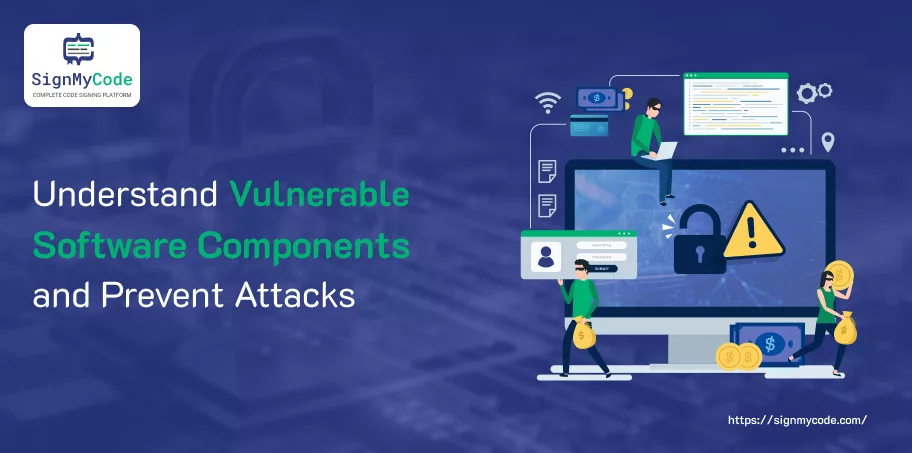What are Vulnerable Software Components? Common Attacks, Identify and Mitigate

The highly competitive digital setting that we have today requires modern software applications to serve as the foundation of business operations, communication, and service innovation.
However, this agility has some risks since outsourcing part of application development to external tools and libraries implies that the organization can unintentionally introduce vulnerabilities that cybercriminals can use against them.
The underlying architectures of applications are insecure or out of date, and, therefore, they may provide exploitations that threaten the integrity of data, availability of systems, and privacy of users.
However, organizations must comprehend the essence of these threats and their inherent risks to devise and implement effective strategies to avoid and mitigate any attacks.
What are Vulnerable Components?
Components that are old, inadequate, or improperly designed, as well as third-party libraries, frameworks, and methods embedded in the coding system, are vulnerabilities.
The components may contain known vulnerabilities, security flaws, bugs, and weaknesses that intruders might exploit to discard access privileges, execute malicious codes, compromise system safety, and defeat system protection.
Disused applications become under attack without replacing or keeping up with outdated components since several types of attacks can be made, ranging from data breaches to system hijacking, from DDoS to other malicious activities, and so on.
The Expanding Attack Surface of Vulnerable Components:
With applications leveraging increasingly external modules to accelerate the process of development and reuse functions, open-source projects have widely spread, and the attack surface materializes with all the possible security rush points the attackers can head to.
Each new element added to the code makes it more intricate and increases the possibility of a security breach. It might incorporate untested and is thus prone to vulnerability, which may harbor hidden flaws and weaknesses in the code.
When these systems in place are brushed aside, not regularly updated, or well maintained, they may provide cybercriminals with opportunities to sneak in with their malicious exploits, which involve gaining unauthorized access, data theft, system compromise, and other malicious activities.
Common Vulnerable Component Attacks:
Remote Code Execution (RCE) Attacks:
RCE attacks play the “deadliest” roles in attacking the exploited components list. Performing these attacks enables terrible guys to get the ability to run code they like, and it could be done due to flaws in the system components.
Efficient RCE exploitation permits data stealing, manipulating the system, and installing malware, including backdoors and payloads. Hence, the attackers get persistent access and control over the region.
SQL Injection (SQLi) Attacks:
SQL Injection attacks exploit the source of unauthorized command input, which is often malicious SQL code, and adversaries can use this opportunity to manipulate database queries.
Through innovative programming, the hackers can successfully exploit vulnerabilities for deception by either trying to access a database, controlling or even deleting data, or even possibly gaining unauthorized access to databases, which can lead to a security breach and system compromise.
Cross-Site Scripting (XSS) Attacks:
XSS attacks are based on exploiting vulnerabilities present in web/pointers that cannot provide code sanitation for user input, which leads to the injection of malicious scripts into web pages.
The attackers can use these scripts to hijack the browsers of the victim, and they can do various illicit activities such as credentials stealing, session loss, defacement of websites, phishing, session stealing, etc.
Identifying Vulnerable Components:
Enterprises should then determine possible weak spots present in their applications by identifying and mapping them first. Several strategies and tools can aid in this process:
Monitoring Vulnerability Databases and Advisories:
Organizations using different application components should track the published vulnerability reports, including those from known vulnerability databases (for example, NVD) or advisories related to those components.
These alerts are highly detailed about discoveries and vulnerabilities, rating their severity, estimated impacts, and a guide on how to mitigate or patch them in the case of newly found vulnerabilities.
Leveraging Software Composition Analysis (SCA) Tools:
The Software Composition Analysis (SCA) tools are meant to be used in analyzing an application’s codebase and depending, which helps in identifying known vulnerable components and provide a detailed report on their prospective risks, updates or patches are also expected to come along with guidance on how to remedy this.
These tools can then be incorporated into the software development lifecycle process, and remedial measures can be taken beforehand to avoid any attack on weak components.
Conducting Penetration Testing and Code Reviews:
Regulation and scan testing of code and reviews can assist in identifying gaps in the built components. They can also help identify configuration mistakes, which may become an entryway to malicious access or exploitation of third-party components.
Recommended: Identify Malicious Code: Examples to Defend Your SDLC
Through the application of the real-world attack context and deep codebase research, organizations would find themselves fortified in advance with the competence to detect and promptly rectify the vulnerabilities that may otherwise fall victim to the attack of the black hats.
Mitigating Vulnerable Component Risks:
After completing a critical component analysis, organizations should employ security schemes that effectively prevent infiltration and unauthorized penetration attempts on their apps and platforms as a risk management strategy. Here are some essential practices:
Implementing a Comprehensive Vulnerability Management Program:
Organizations need to set up an efficient vulnerability management program that involves procedures such as vulnerability identification, prioritization, and remediations promptly using the pecking order, which may get these affected by the incorporated vendors.
Recommended: What is Code Signing SDLC?
The mechanism must ensure that it incorporates transparent policies, carries out responsibilities justly and clearly, and puts methods for risk assessment, patch management, and incident response in place.
Enabling Continuous Monitoring and Patching:
Constant observations are invariably needed to keep up with the news and updates regarding the security breaches of the adopted components.
By automating processes regarding observing and applying patches, the vulnerabilities that attackers target will be significantly reduced, which also helps a lot when the vulnerabilities are exposed.
Therefore, these windows of possibility are promptly patched, and unauthorized entry is prevented.
Adopting a Secure Software Development Lifecycle (SDLC):
While you must use security practices throughout the life cycle of the software development, l can help you identify and manage it during production, which will lead to a reduced risk of shipping applications with vulnerable components.
Deploying an SSDLC in place, it is possible to develop secure coding practices, employ security testing procedures, perform vulnerability scanning methodologies, and provide vulnerability remediation stages during both development and testing phases just shortly before the production environment, reducing the introduced vulnerability chances.
Implementing Vendor Risk Management:
Companies should check the security practices and risk exposure management processes of third-party vendor suppliers with whom they share their third-party libraries.
The vendor risk management process must include assessing whether the vendors’ software development practices, patch management policies, or commitment to security are acceptable.
Organizations can better control the risks of using third-party products by partnering closely with vendors and including them in product security checks and oversight processes.
Adhering to Access Control and Least Privilege Principles:
Saving the affected resource is crucial, and such can thwart the possibility of a successful attempted attack on exposed parts.
Limiting the extent of a security attack is possible by restricting access to the information source and only allowing the user requisite privileges. This will make it harder for an attacker to broaden the scope of an attack once a vulnerability is identified.
Conclusion
Software components with a considerable risk of compromise pose a significant threat to apps and systems and the growth of the digital marketplace. Security concerns in such organizations rise as they begin during third-party libraries and networks.
However, paying attention to these threats is of utmost importance, as well as developing precautionary and danger-handling strategies.
Recommended: Safeguard your Business and Device from Microsoft Office Vulnerabilities
Implementing vulnerability management with decent continuous tests, secure programming methods, vendor evaluations, internal user restriction principles, and compliance must become vital.
Since early-stage vulnerability identification within software development lifecycles is deemed a pivotal step to minimize cyber-attacks against assets, organizations can resolve and proactively manage their digital assets for current and future threats.
To achieve a solid position, an all-inclusive approach that embraces security at every stage of development and deployment of the definitive version should be applied to reduce the possibility of insecure components ending in DDoS attacks.
Recommended: Most Common Cybersecurity Challenges of Software Developers
For the data integrity and systems integrity to be kept safe and impenetrable, dedicated efforts must be made to address the risks of exposed components.
Frequently Asked Questions (FAQs)
What are the Potential Consequences of Using Vulnerable Components in Software Applications?
Engineers can be pushed into vulnerabilities that can quickly escalate to the level of data breaches, system compromise, unauthorized access, and other security incidents. Such events can cause financial damage, reputational harm, legal hazards, and breakoffs of crucial business processes.
How can Organizations Identify Vulnerable Components within their Applications?
Organizations can pinpoint vulnerable nodes by scanning data on vulnerability repositories and advisory databases, being supported by code composition analysis tools, and engaging in regular penetration testing and code reviews.
These tools allow you to fully validate a security architecture by pinpointing known weaknesses, no longer-in-use or up-to-date components, and misconfigurations that can be used as an entry point.
What is the Importance of Continuous Monitoring and Patching for Vulnerable Components?
Regular surveillance and timely fixing of flaws are the priorities to prevent damage fostered by insecure elements. With the revelation of new risks and eventual patching, the exposure time is significantly reduced due to limitations to successful attacks.
Can Organizations still use Components with Known Vulnerabilities?
It is widely advised not to use components with established vulnerabilities because the vulnerabilities will be exploited, and the apps and systems will be at risk of compromise.
If the alternative component is lost or unavailable, controls to compensate for it can be applied, such as restriction of access and enhanced monitoring. This may only be temporary until the occurrence of a security default or whenever a secure alternative or patch becomes available.
How can Organizations Ensure the Security of third-party Components?
The only way to secure third-party parts is to apply the rules and procedures of vendor risk management. This means reviewing vendors’ security maturity, vetting vulnerable management processes, and setting up compliance processes for their products.
What is the Role of Secure Software Development Practices in Mitigating Vulnerable Component Risks?
Diligently following secure code development principles and using the safe software development process, including introducing SSDLC, can be of significant use in minimizing the number of software components that introduce vulnerabilities to the environment under production.
Intertwining security testing along with vulnerability scanning and mitigation efforts in the development process streamlines the process and enables it to achieve high-end security at the end of the development cycle.
How can the Principle of Least Privilege help Mitigate the Risks associated with Vulnerable Components?
The implementation of the principle of least privilege can mitigate the possible destruction attacks targeting components with weak security.
This could be done by closing access to sensitive resources and barely handing out the least possible permissions to organized components. This way, an attack will not spread to the rest of the system if a vulnerability in one component is exploited.


